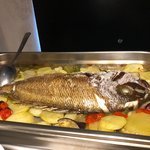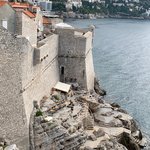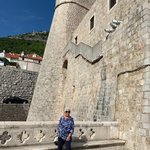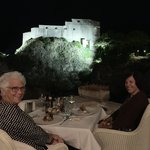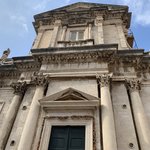Highlights
- Visit Plitvice Lakes National Park and see waterfalls and emerald-green lakes
- Discover Split and learn about its 1,700-year-old history
- Watch the sunset over the Elafiti Islands from Srđ Mountain in Dubrovnik
- Tour the Konavle wine country and sample wines from three well-known and traditional wineries
Brief Itinerary
| Day | Highlights | Overnight |
|---|---|---|
| Day 1 | Welcome to Zagreb! | Zagreb |
| Day 2 | Zagreb to Plitvice Lakes National Park | Plitvice Lakes National Park |
| Day 3 | Plitvice Lakes at Sunrise, Drive to Split | Split |
| Day 4 | Ferry from Split to Korčula | Korčula Town |
| Day 5 | Korčula to Dubrovnik via Pelješac Peninsula | Dubrovnik |
| Day 6 | Konavle Wine Tasting Tour | Dubrovnik |
| Day 7 | Depart Dubrovnik |
Detailed Itinerary
Day 1: Welcome to Zagreb!

Start your adventure from Zagreb, the capital of Croatia. Upon arrival at the airport, you'll be transferred to your hotel to settle in. The rest of the day is yours to spend as you like. The city center is easily walkable and the streets and parks are easy to navigate by foot. All the main attractions and restaurants are within walking distance.
A gem of a European city, Zagreb is at once historic and new. It's filled with leafy green parks and gothic/neo-renaissance buildings, yet there's also modern shopping complexes, outdoor malls, and endless dining and drinking options. Consider heading out on a guided walking tour of the historic heart of the city. This involves walking from the main square to Zagreb's Upper Town and passing through local markets before reaching St. Mark's Square.
Alternatively, you can visit one of the many museums and art galleries, like the Homeland War Museum, the Nikola Tesla Technical Museum, or the ever-popular Museum of Broken Hearts. Or stroll through the city center, enjoying 17th-century neo-baroque architecture found at Zagreb's Art Pavilion and Croatian National Theater.
Zagreb also has a number of beautiful city parks which are great for exploring and people watching, especially in the late afternoon. Maksimir is a great option, with a variety of cafés nearby to pick up a coffee for your stroll.
Day 2: Zagreb to Plitvice Lakes National Park

Today, you'll make the drive south to Plitvice Lakes National Park, one of Croatia's most popular national parks. Along the way, make a point to stop at Rastoke. Rastoke is a small village known for its old watermills and beautiful waterfalls as two rivers converge in the area. This is a nice precursor of the sights to come at Plitvice Lakes.
A short drive later, you'll arrive at Plitvice Lakes National Park in the early afternoon and can explore the park at your leisure. A must-visit for any traveler to Croatia, the UNESCO-protected park is comprised of an exquisite collection of 16 glassy emerald green and blue travertine lakes, more than 90 cascading waterfalls that seemingly cover every corner of the park, and numerous caves. The terraced lakes are surrounded by beech and pine forests and are home to extensive wildlife.
Choose one of eight different hiking trails, ranging from three to eight hours in duration, where the upper lakes tend to be less crowded during the peak season. You may wish to bring a bought lunch (and a bottle of wine!) with you to enjoy a picnic. Tickets are purchased at the entrance of the Park.
Driving time (Zagreb to Rastoke): 1.5-2 hours
Day 3: Plitvice Lakes at Sunrise, Drive to Split

Early morning is one of the best times to visit Plitvice Lakes before the crowds arrive just before noon. You can explore the park on your own or opt for a local guide who can take you on a number of defined routes of varying length throughout the park. You'll hike along the many wooden paths and bridges, in and around a series of 16 emerald-green and blue travertine (a type of limestone) lakes, more than 90 waterfalls, and numerous caves.
From Plitvice, continue toward the Dalmatian coast and farther south to Split. Upon arriving in Split, check into your hotel and settle into your accommodation before taking the rest of the afternoon to wander Split's historic center.
Start at Pjaca Square for pretty views of white marble tiles, the Iron Gate (the western entrance to Diocletian's Palace), a Romanesque clock tower with the remains of a medieval sundial, and the 15th-century Town Hall. Stop for lunch at Trattoria Bajamont, just north of the Iron Gate. From there, visit the popular Voćni trg or Fruit Square. Here you can enjoy renaissance architecture, influenced during Split's Venetian era. For a bit of shopping and a bite to eat head to Marmont Street, though you'll want to head to the waterfront to catch the sunset.
In the evening, take a stroll along Split's seafront Riva to admire the waterfront views before finding the off-beat Konoba Dioklecijan restaurant, just to the left of the Bronze Gate for a bite to eat, its outdoor terrace built into the walls of Diocletian's Palace.
Driving time (Plitvice to Split): 2-3 hours
Day 4: Ferry from Split to Korčula

Take the morning to check out Split's Green Market (Pazar Market), a lively fruit and vegetable outdoor market just east of the Diocletian Palace. This is a great place to see how the locals shop and to pick up some fruit for your ferry ride to Korčula.
Once on Korčula, the afternoon and evening are yours to discover this little island's numerous restaurants, taverns, shops, and bars as you roam the maze of gray stone houses, alleys, churches, and squares.
Enjoy a traditional lunch of lamb and goat in Korčula's Old Town, one of the finest examples of Venetian architecture on the Dalmatian coast. Next, visit the 14th-century Land Gate on top of an elegant staircase, before heading to the St. Mark's Cathedral to admire its strange sculptures of beasts and people. Art enthusiasts will appreciate a visit to the Bishop's Treasury next door for a small but impressive art collection, including works from Carpaccio, Bassano, and Tiepolo. From there, you may wish to visit the unremarkable house thought to be the birthplace of Marco Polo.
If beaches are what you're after, rent a bike or scooter or ride the bus the 5 miles (8 km) to the sandy beaches of Lumbarda. Afterward, grab a bite to eat and pair it with the local dry white, Grk, indigenous to Lumbarda and nowhere else.
Ferry time (Split to Korčula): 4 hours
Day 5: Korčula to Dubrovnik via Pelješac Peninsula

Today you'll leave Korčula and transfer to Orebić on the Pelješac Peninsula and continue your journey south to Dubrovnik. En route, stop in the medieval city of Ston to explore one of the longest defensive stone walls in Europe (originally built to keep predators away from the town's saltpans) and discover the importance this area held in the 14th century. Enjoy beautiful views over Ston and its glittering saltpans from a parapet walkway on Ston's 3,937-foot (1,200 m) wall.
Reward your efforts with a light meal of Ston's famous fresh oysters or mussels accompanied by a glass of local Dingač red wine. Should you choose, you can take a tour of one of the area's family-run wineries and sample Dingač's famous reds.
When you're ready, make your way to the historic coastal fortress city of Dubrovnik. The remainder of the day will be at your leisure, allowing time for you to wander and explore this magical city. Depending on when you arrive, you may have time to hop aboard a cable car and ride to the top of Srđ Mountain for stunning vistas of Dubrovnik and the nearby Elafiti Islands.
Ferry time (Korčula to Orebić): 30 minutes
Driving time (Orebić to Ston): 1 hour
Driving time (Ston to Dubrovnik): 1 hour
Day 6: Konavle Wine Tasting Tour

This morning you'll head to Konavle, a famous wine region outside of Dubrovnik, where you'll visit three wineries and their famous winemakers—all families whose tradition of winemaking has endured for centuries.
The tour lasts six hours and starts with a shuttle transfer and a panoramic drive along the coast to Konavle. First, you'll stop at the awarded winemaker, Crvik, to taste the local white, red, and rosé, including a unique white, Dubrovacka malvasia, pressed from old grapes from the days of the Dubrovnik Republic.
Next, you'll continue to another winery belonging to the Ljubić family, where you'll taste merlot and a variety of herb liqueurs, as well as enjoy a traditional meal in their wine cellar. From here, you'll carry on through the Konavle Valley to the Karaman family's award-winning winery to sample their dry dessert wines, Prošek alongside traditional Padispanj cake.
Day 7: Depart Dubrovnik

Depending on when you depart, you may have time to visit one of Dubrovnik's museums, like the Franciscan Monastery and Museum. This large complex houses many treasures, including the world's third oldest pharmacy dating from 1317.
Alternatively, for a collection of 15,000 pieces of interesting works, visit the Rector's Palace and Cultural Historical Museum. Wander this well-preserved palace-turned-museum and explore its exhibits, some detailing life in the Republic of Ragusa during medieval times.
The drive to the airport from Dubrovnik takes around 45 minutes with normal traffic.
This trip was selected as one of Europes best itineraries. See the full list here



